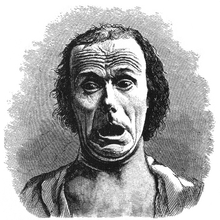User:Laurenrampey/modifiedarticles2
Emotionality is the observable
Examples of emotionality

- Facial expressions
- Smile
- Frown
- Creased forehead
- Raised eyebrows

- Wide eyes
- Physiological responses
- muscle tension
- elevated heart rate
- sweating
- nausea
- shaking
- gastrointestinaldistress
- Observable behavior
- averted gaze
- avoidance
- excitement
- fidgeting
- gasping
Early theories of emotion
By the late 1800s, many high-quality contributions had been made to the theory of emotion by psychologists and scientists such as
Emotion as irrational
One of the oldest issues of emotion is the one that believes emotion indicates inferiority. In early psychology, it was believed that passion (emotion) was a part of the soul inherited from the animals and that it must be controlled. Solomon identified that in the Romantic movement of the eighteenth and nineteenth centuries, reason and emotion were thought to be opposites.[2]
Emotion as physiological
Physiological responses to emotion are originated in the brain, the central nervous system, the autonomic nervous system, and the endocrine system. Some of the responses include: heart rate, sweating, rate and depth of respiration, and electrical activity in the brain. Many researchers have attempted to find a connection between specific emotions and a corresponding pattern of physiological responses, although it is said that these attempts have rendered unsuccessful conclusions.[2]
Theories of emotional response
The significant theories of emotion can be divided into three primary categories: physiological
James-Lange theory of emotion
The
Cannon-Bard theory of emotion
The
Schachter-Singer theory of emotion
Stanley Schachter and Jerome Singer proposed a theory also know as the two-factor theory of emotion, which implies emotion have two factors: physical arousal and cognitive label. This suggests that the physiological activity occurs first, then we must cognitively distinguish the cause of the arousal and label it as an emotion. Using the example of a car coming toward you in your lane, your heart would start to race and you would identify that you must be afraid if you heart is racing, and from there you would begin to feel fear.[7]
Gender differences
The opposition of rational thought and emotion is believed to be paralleled by the similar opposition between male and female. According to Crawford et. al. (1992), "men are seen as rational and women as emotional, lacking rationality."
When engaging in social interaction, studies show that women smile significantly more than men do. Although the results are meaningful, it is still difficult to determine the exact difference between males and females to explain this disparity. It is possible that the best explanation for this difference in expression of emotions could be due to
Expression of emotion across cultures
It is believed that there are six universal emotions which expand across all cultures. These emotions are: happiness, sadness, anger, fear, surprise, and disgust (there is some argument that contempt should be combined with disgust, though it is not as widely accepted).[12] According to Ekman (1992), each of these emotions have universally corresponding facial expressions as well.[13] In addition to the facial expressions that are said to accompany each emotion, there is also evidence to suggest that certain autonomic nervous system (ANS) activity is associated with the three emotions of fear, anger, and disgust. Ekman (1992) theorizes that these specific emotions are associated with the universal physiological responses due to evolution. It would not be expected to observe the same physiological responses for emotions not specifically linked to survival, such as happiness or sadness.[12]
References
- ^ ISBN 0-14-051451-1.)
{{cite book}}: CS1 maint: multiple names: authors list (link - ^ a b c d e Crawford, J., Kippax, S., Onyx, J., Gault, U., & Benton, P. (1992). Emotion and gender: Constructing meaning from memory. London, England: Sage Publications. pp. 16–18.
{{cite book}}: CS1 maint: multiple names: authors list (link) - ^ a b Hall, J. A., Carter, J. D., Horgan, T. G. (2000). Gender differences in nonverbal communication of emotion. United Kingdom: Cambridge University Press. pp. 97–117.
{{cite book}}: CS1 maint: multiple names: authors list (link) - ^ Darwin, Charles (1872). The expression of the emotions in man and animals. London, England. pp. 278–309.
{{cite book}}: CS1 maint: location missing publisher (link) - doi:10.1111/j.1540-5834.1994.tb01283.x.)
{{cite journal}}: CS1 maint: multiple names: authors list (link - ^ doi:10.1037/h0072957.)
{{cite journal}}: CS1 maint: date and year (link - ^ PMID 14497895.)
{{cite journal}}: CS1 maint: multiple names: authors list (link - ^ a b James, W. (April 1884). "What is an emotion?". Mind (Oxford University Press). 9 (34): 188–205.
{{cite journal}}: CS1 maint: date and year (link) - PMID 8022957.
- PMID 29743808.)
{{cite journal}}: CS1 maint: multiple names: authors list (link - ^ Ryff, C. D., Singer, B. H. (2001). Integrating emotion into the study of social relationships and health. New York, NY: Oxford University Press. pp. 3–22.
{{cite book}}: CS1 maint: multiple names: authors list (link) - ^ PMID 1344638.
- .
Category:Emotion Category:Emotions Category:Behavioral neuroscience
